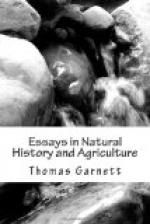I remember seeing an article in the “Scotsman,” perhaps about twelve months ago, in which it was stated that Dr. Knox had made some important discoveries in the natural history of the Salmon and Herring, both in their food and propagation, and, if I recollect aright, it stated that he had ascertained that the eggs remained several months in the gravel, and that then, in a few days or weeks after, they (i.e. the fish hatched from them) were so much grown as to go down to the sea; but none of the data which enabled him to arrive at this conclusion were given, and since then I have heard nothing about the matter. As it is so long since I read this article, I may have quoted it incorrectly, but I believe its substance was what I have stated.
The only conclusive evidence I can find about the hatching of Salmon fry is that of Mr. George Hogarth (second Parl. Report, p. 92), and his account agrees with my own: he states that he took Salmon spawn from the spawning beds, and by keeping it freely supplied with fresh water, he succeeded in hatching some of the eggs; he gives drawings of the appearance of the fry in three or four different stages, from the egg to the age of eight days (see Appendix to second Parl. Report), that the young fry, by keeping them well supplied with fresh water, were very lively and vigorous for three weeks, but that they after this time appeared to grow languid and uneasy, and as they would eat nothing they died when one inch long. Unfortunately he does not state at what time of the year they were hatched, but if this were in March or April, which I see no reason to doubt, it is sufficient to prove that they would not reach the size that Smolts are when they leave the river for the sea; for supposing them to be hatched the last week in March, and that they lived a month, this would bring us to the time when they are about to migrate, at which time they average more than six inches long; many of them are eight inches, and at this period they are fond of feeding upon worms, flies, maggots, and caddis worms, as is known to every schoolboy living on the banks of a river frequented by Salmon. It is also my opinion that neither Salmon nor Trout spawn every year, [2] for Salmon ascend the river as early as January, in the highest condition, with roe in them no bigger than mustard seed: these




